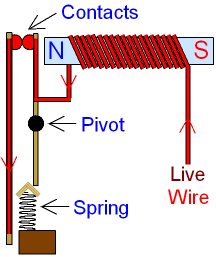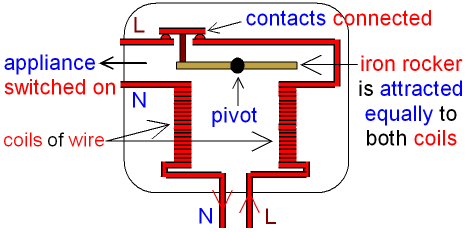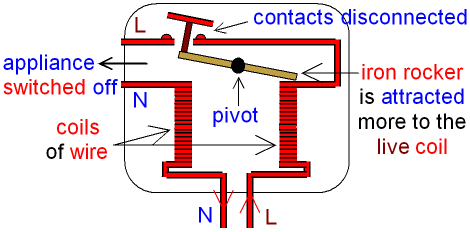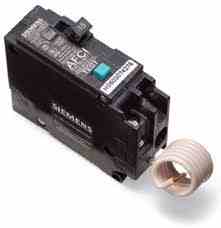greybeard
Herd Master
(am having problems staying connected today, so this may come out in bits and pieces)
This is about electricity in general, mostly regarding household current, safety, how electricity "works" and not about electric fencing, as hot wire fencing topics have been discussed multiple times over the years. As always, if I say something in error, especially from a safety standpoint, please DO correct me--I am not an engineer. (I just found the hat on the side of the road)
What is electricity? Well, it is in basic form, it is current flow. It occurs naturally, all around us, and of course produced by our regional or local energy provider.
That, is what it is. Now what is it NOT?
I have been surprised over the years by the number of people that think electricity is 'something' in and of itself. It is not an element, you won't find it on the Periodic table, it has no atoms or molecules. It can be stored, but you can never hold it physically in your hand, even if it couldn't shock you.
All the utility companies do, is begin the process of 'current flow' at their generators, and the rest is done by the atoms of the conductors between the generator and your house.
How does current flow? By movement of electrons that make up the conductors' atoms. I will use copper atoms since that is the most common conductor in our homes and farms. Copper atoms are made up of a nucleus containing protons, (a positive charged particle) Neutrons (no or neutral charged) and rings of electrons around the nucleus. Electrons are generally accepted top have a negative charge and as a result, are held in their respective rings by the attraction to the protons in the nucleus. (not always true, but for this discussion, close enough).
A copper atom:

Now this isn't how an atom really looks, but it's how we present it for easier understanding and all we really need to look at is the outermost ring or shell where that single electron is. This is called the valence shell. Because of it's distance from the nucleus (and the attracting protons) the electron in the valence shell, is very loosely associated with that particular atom. It can be knocked off that copper atom by another particle. When it is knocked off, almost always by a valence electron from an adjacent copper atom, to moves immediately to the next copper atom, knocking that copper atom's valence out of it's shell to do the same thing to the next atom. This colliding of free electrons takes place in every conductor, even if not connected to a source field, such as a generator, but the free electrons collide in a random fashion, just bouncing around with no "sense of direction".
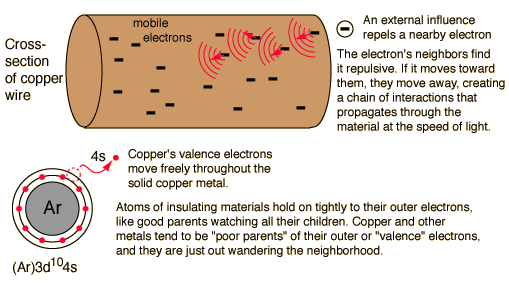
(electrons don't actually hit' each other tho. Each has it's own electromagnetic field, as one free electron approaches the free electron in another atom, the electromagnetic field of the 1st electron causes the free electron in the next atom's valence shell to move. Like charges repel, so an electron approaching another electron causes that approached electron to move out of it's ring and go to another atom.
When a utility company's generator begins to spin, an electromagnetic field in the output conductors is created, in one direction--down the line and eventually to the transformer in front of our homes. One valence (free) electron moving down the wires to the next atom. They are still bouncing or drifting somewhat randomly, but as a group, they now have direction.
This, is current flow. The movement of those free copper valence electrons from one copper atom to the next. (Now you see why there is no such thing as electricity in and of of itself. It's simply the movement of the conductor's own free electrons along that conductor.
How fast does electricity travel?
Dang fast. Ever had a power outage and even tho the problem may be many miles away, the millisecond the power guys throw the line switch back on, voila..your lights come on. The current flow (electricity) doesn't travel along the conductors at the speed of light, but pretty close to it..about 95% the speed of light. In a vacuum, it would travel at the speed of light , but in air, it does not, and movement along a resistive conductor, even copper slows it down only a little more, to about .
Light speed is generally said to be 186,000 miles per second.
Electricity in a copper conductor travels approx at 173, 984 miles per second, depending on conductor size, frequency etc. Still....very fast.
Now, tho it's obvious electricity moves at a high velocity, that doesn't mean the individual electrons themselves do. A snail would beat them in a race. A free electron drifts at the velocity of about 3 ft/hour, but because the copper atoms are so densely packed so closely together, it means movement from one atom's valence ring to another takes very little 'time', and the whole group of valence electrons within any measured length of copper conductor moves at 173,984 MPH.
Now, we know what electricity is, and how it 'moves' to our houses, farms and in the circuits of those homes and outbuildings.
I'll continue in another post.
This is about electricity in general, mostly regarding household current, safety, how electricity "works" and not about electric fencing, as hot wire fencing topics have been discussed multiple times over the years. As always, if I say something in error, especially from a safety standpoint, please DO correct me--I am not an engineer. (I just found the hat on the side of the road)
What is electricity? Well, it is in basic form, it is current flow. It occurs naturally, all around us, and of course produced by our regional or local energy provider.
That, is what it is. Now what is it NOT?
I have been surprised over the years by the number of people that think electricity is 'something' in and of itself. It is not an element, you won't find it on the Periodic table, it has no atoms or molecules. It can be stored, but you can never hold it physically in your hand, even if it couldn't shock you.
All the utility companies do, is begin the process of 'current flow' at their generators, and the rest is done by the atoms of the conductors between the generator and your house.
How does current flow? By movement of electrons that make up the conductors' atoms. I will use copper atoms since that is the most common conductor in our homes and farms. Copper atoms are made up of a nucleus containing protons, (a positive charged particle) Neutrons (no or neutral charged) and rings of electrons around the nucleus. Electrons are generally accepted top have a negative charge and as a result, are held in their respective rings by the attraction to the protons in the nucleus. (not always true, but for this discussion, close enough).
A copper atom:

Now this isn't how an atom really looks, but it's how we present it for easier understanding and all we really need to look at is the outermost ring or shell where that single electron is. This is called the valence shell. Because of it's distance from the nucleus (and the attracting protons) the electron in the valence shell, is very loosely associated with that particular atom. It can be knocked off that copper atom by another particle. When it is knocked off, almost always by a valence electron from an adjacent copper atom, to moves immediately to the next copper atom, knocking that copper atom's valence out of it's shell to do the same thing to the next atom. This colliding of free electrons takes place in every conductor, even if not connected to a source field, such as a generator, but the free electrons collide in a random fashion, just bouncing around with no "sense of direction".

(electrons don't actually hit' each other tho. Each has it's own electromagnetic field, as one free electron approaches the free electron in another atom, the electromagnetic field of the 1st electron causes the free electron in the next atom's valence shell to move. Like charges repel, so an electron approaching another electron causes that approached electron to move out of it's ring and go to another atom.
When a utility company's generator begins to spin, an electromagnetic field in the output conductors is created, in one direction--down the line and eventually to the transformer in front of our homes. One valence (free) electron moving down the wires to the next atom. They are still bouncing or drifting somewhat randomly, but as a group, they now have direction.
This, is current flow. The movement of those free copper valence electrons from one copper atom to the next. (Now you see why there is no such thing as electricity in and of of itself. It's simply the movement of the conductor's own free electrons along that conductor.
How fast does electricity travel?
Dang fast. Ever had a power outage and even tho the problem may be many miles away, the millisecond the power guys throw the line switch back on, voila..your lights come on. The current flow (electricity) doesn't travel along the conductors at the speed of light, but pretty close to it..about 95% the speed of light. In a vacuum, it would travel at the speed of light , but in air, it does not, and movement along a resistive conductor, even copper slows it down only a little more, to about .
Light speed is generally said to be 186,000 miles per second.
Electricity in a copper conductor travels approx at 173, 984 miles per second, depending on conductor size, frequency etc. Still....very fast.
Now, tho it's obvious electricity moves at a high velocity, that doesn't mean the individual electrons themselves do. A snail would beat them in a race. A free electron drifts at the velocity of about 3 ft/hour, but because the copper atoms are so densely packed so closely together, it means movement from one atom's valence ring to another takes very little 'time', and the whole group of valence electrons within any measured length of copper conductor moves at 173,984 MPH.
Now, we know what electricity is, and how it 'moves' to our houses, farms and in the circuits of those homes and outbuildings.
I'll continue in another post.
Last edited:




